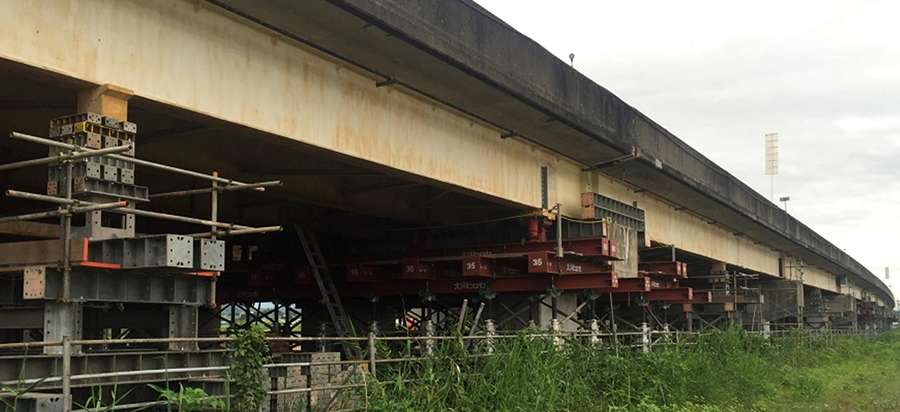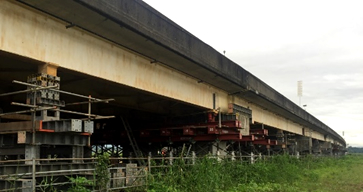Disaster Restoration
Restoring for infrastructure and damaged structures
Damage caused by natural disasters, including earthquakes, typhoons, abnormal torrential rains, and tornadoes, has grown increasingly severe in recent years.
To contribute to the fastest possible recovery in stricken areas, we work as partners in emergency restoration efforts involving the transportation infrastructure, including expressways and Shinkansen, and private industrial facilities, such as power plants, ironworks, and oil refineries, all linchpins of recovery.
Following the Great East Japan Earthquake, we took part in several projects, including filling the foundations of Shinkansen power poles and rebuilding expressway slopes, while proposing optimal designs for specific sites.
Restoring lifelines as quickly as possible
Emergency restoration works after the Kumamoto Earthquake (Kiyamagawa-bashi)

The Kumamoto Earthquake on April 14, 2016 seriously damaged the Kiyamagawa-bashi bridge linking the Mashiki Kumamoto Airport and the Matsubase on Kyushu Expressway, close to the epicenter. As Kyushu Expressway was an arterial road, decisions were made to support the beams of the Kiyamagawa-bashi bridge temporarily with BH piles (780 m of the road and 300 bearing piles) aiming to increase the speed limit to 50 km by the end of May.
We mustered 10 sets of machines and 17 construction teams from across the country during Golden Week holidays. Some 90 of us worked and completed the works in May as aimed. After that, we installed a temporary jetty and started full-scale restoration works. On April 28, 2017, all the four lanes were restored between the Mashiki Kumamoto Airport and the Matsubase.
Related technologies
Preventing spread of contaminated water
Nuclear power plant

A nuclear power plant was damaged due to a great earthquake and the groundwater flowing into the reactor building had to be prevented from being contaminated with radiation. To control an increase in contaminated water, our Ground Freezing was chosen. Ground Freezing provides high water cutoff properties and allows creation of frozen walls even among numerous buried objects. In addition, if a frozen wall is damaged, it can be frozen again to be renewed. Our Ground Freezing was chosen for these reasons.
Our Ground Freezing was chosen to prevent the groundwater passing the disaster-stricken nuclear power plant from flowing into the sea as radioactive water. Ground Freezing was chosen because complete water cutoff was required without leakage of any radioactive contaminants.
Related technologies
Examples presented
Emergency restoration works after the Kumamoto Earthquake (Kiyamagawa-bashi)

| Area | Kumamoto |
|---|---|
| Objective | Disaster Restoration |
| Techniques | Diaphragm Wall/Cast-Place-in Pile |
| Period | 05/2016~12/2016 |
| Comment | (12/2004~7/2005) |


